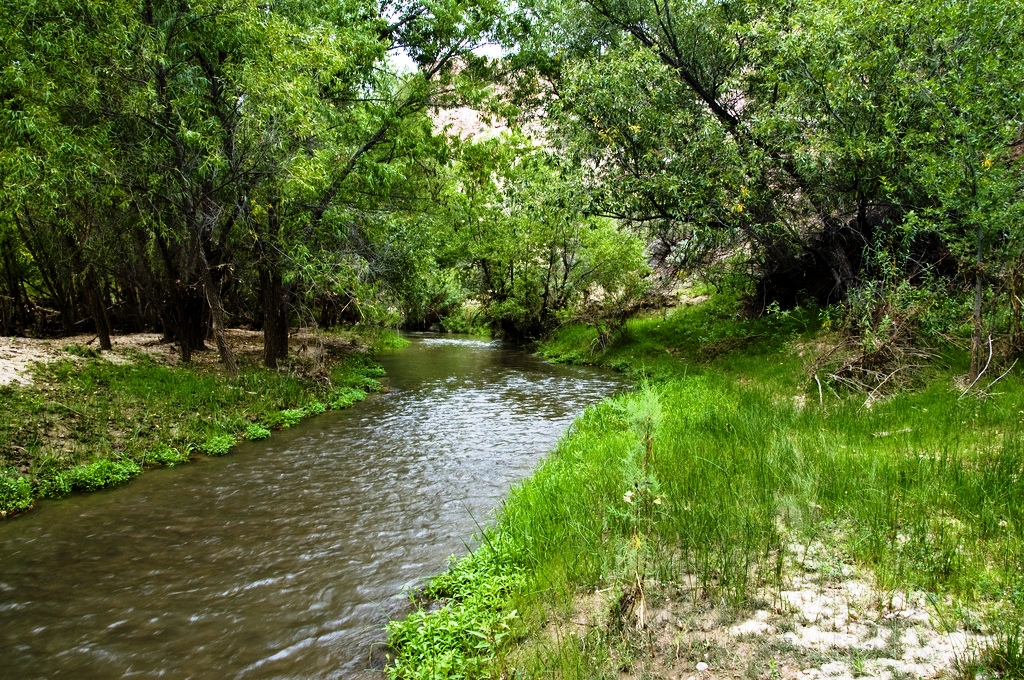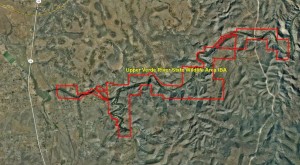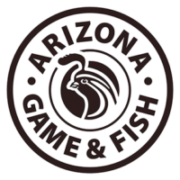Location: 3858479N 367626E UTM NAD83
County: Yavapai
Site Status: Identified 06/2008
Ownership: Arizona Game and Fish and State Trust
Area: 2.8 square miles, 1,809 acres
Criteria: D1 – Site Important to Special Status Avian Species – Yellow-billed Cuckoo, Lucy’s Warbler, Yellow Warbler and others.
D4ii – Significant Concentrations of Birds – Landbirds, Riparian bird diversity
 Site Description: The Upper Verde River Wildlife Area IBA, is located approximately eight miles north of Chino Valley in Yavapai County, Arizona. The IBA consists of 2145 acres located along the upper Verde River and lower Granite Creek. The primary management emphasis for the Upper Verde River property is to manage riparian habitat and maintain native fish diversity. Secondary management emphases are environmental education and compatible wildlife oriented recreation.
Site Description: The Upper Verde River Wildlife Area IBA, is located approximately eight miles north of Chino Valley in Yavapai County, Arizona. The IBA consists of 2145 acres located along the upper Verde River and lower Granite Creek. The primary management emphasis for the Upper Verde River property is to manage riparian habitat and maintain native fish diversity. Secondary management emphases are environmental education and compatible wildlife oriented recreation.
 The Upper Verde River property includes approximately 3.5 miles of the upper Verde River, draining easterly from the headwaters, past the confluence with Granite Creek to the U.S.D.A. Forest Service, Prescott National Forest boundary downstream. Approximately 1.5 miles of Granite Creek upstream from its confluence at the Verde River is within the Wildlife Area. Within the Verde River section are some State Trust Lands (1056 ac.) under a Special Land Use Permit held by the Arizona Game and Fish Department.
The Upper Verde River property includes approximately 3.5 miles of the upper Verde River, draining easterly from the headwaters, past the confluence with Granite Creek to the U.S.D.A. Forest Service, Prescott National Forest boundary downstream. Approximately 1.5 miles of Granite Creek upstream from its confluence at the Verde River is within the Wildlife Area. Within the Verde River section are some State Trust Lands (1056 ac.) under a Special Land Use Permit held by the Arizona Game and Fish Department.
The Upper Verde River Property includes the associated riparian area, floodplains, cliffs, and adjacent uplands. The diverse topography is dissected, ranging in elevation from 4,200 to 4,600 feet. The width of the river channel and floodplain varies from < 0.1 to > 0.5 mile within the IBA. Prominent cliffs rise 100-300 feet above the river in some segments.
Riparian vegetation is characterized as mixed broadleaf deciduous, dominated by Arizona ash (Fraxinus velutina), boxelder (Acer negundo), Arizona walnut (Juglans major) and netleaf hackberry (Celtis reticulata). Tamarisk (Tamarisk pentandra) is occasionally interspersed with native tree species. Gooddings willow (Salix gooddingii), red willow (Salix laevigata) and Fremont cottonwood (Populus fremontii) are also present. Low floodplain terraces are dominated by large stands of desert willow (Chilopsis linearis), while highest terraces are vegetated with velvet mesquite (Prosopis velutina). Varying from the above, the lower Granite Creek supports a well-developed narrowleaf cottonwood (Populus acuminata) riparian forest.
Public Use Opportunities and Resource Management Emphasis
The primary management emphasis for the Upper Verde River property is to manage riparian habitat and maintain native fish diversity. Secondary management emphases are environmental education and compatible wildlife oriented recreation.
Native fish populations in the upper Verde River, inclusive of the Wildlife Area, are among the most diverse in Arizona. Because native fish diversity and abundance are valuable indicators of biotic integrity, a management focus is to monitor, manage, and maintain the extant native fish populations.
Upper Verde River | Arizona Wildlife Conservation Strategy
For an interactive map and habitat and land ownership analysis of this IBA visit the National Audubon IBA Map and select “Arizona” and then select this IBA
Ornithological Summary: South of the Colorado River, the Verde River represents the most significant perennial waterway in the northern 1/3 of the state. Aside from supporting rare or priority riparian breeding species, it serves as an important stopover and/or wintering grounds for a host of migratory birds. The Upper Verde River Wildlife Area (the IBA) contains the headwaters of the Verde River. It provides breeding habitat for species of conservation concern (special status species) in Arizona, including the: Western Yellow-billed Cuckoo, Yellow Warbler, and Lucy’s Warbler, all which occur in significant numbers within the IBA. Other species of conservation concern occur in low numbers, they include: Bald Eagle (winter), Ferruginous Hawk (winter), Golden Eagle (possible one breeding pair), Southwestern Willow Flycatcher (migration/breeding?), Peregrine Falcon (migration), Red-naped Sapsucker (migration and winter), Crissal Thrasher (resident?), Sage Thrasher (winter-rarely), Black-throated Gray Warbler (breeding), and MacGillivray’s Warbler (migration). This IBA is also significant in Arizona because of the breeding diversity of riparian obligate and riparian dependent species. These species breed and forage in migration along or near the two main riparian lined watercourses, the Verde River and Granite Creek, they include the aforementioned Yellow-billed Cuckoo, Yellow Warbler, and Lucy’s Warbler, also Great Blue Heron (high #s breeding & in migration), Green Heron, Summer Tanager (very high numbers breeding and in migration), Yellow-breasted Chat, Common Yellowthroat, Black Phoebe, Song Sparrow, and Blue Grosbeak.
The Upper Verde Wildlife Area also contains Pinyon-Juniper vegetation, providing foraging habitat for Pinyon Jays (Audubon WatchList Yellow/Declining) and Juniper Titmice (AZ PIF Priority), both special status species that have been recorded in fall and winter periods within the IBA. White-throated Swifts (Nation PIF WatchList) have been recorded foraging over Granite Creek in spring and Cinnamon Teal may nest along the Stillman Lake area of the Wildlife Area. Osprey have also been observed at Stillman Lake at different times of the year.
Lastly, this IBA is particularly important as a wintering area for many Arizona breeding species of higher elevations. Many birds associated with riparian and other habitats of mountainous country immediately north of this IBA, find the Upper Verde Wildlife Area as the closest low elevation mesic-riparian area they encounter when they leave their breeding areas with the on-set of winter and reduced foraging opportunities. Hence, the Upper Verde WA attracts high numbers of American Robin, and regular occurrence of Mountain Chickadee, Cedar Waxwing, Red-naped Sapsucker, Townsend’s Solitaire, Western Bluebird, Mountain Bluebird, Brown Creeper, and Dark-eyed Junco. Occasional short-distance migrants from the Colorado and Great Basin eco-regions have also been recorded within the IBA, they include the Sage Thrasher, Dark-eyed Junco (“Gray-headed”), and Brewer’s Sparrow.
Grazing was once prominent within the Upper Verde Wildlife Area. Although illegal grazing continues to occur, the habitat has improved dramatically since the Arizona Game and Fish Department purchased the property in 1996. The habitat will continue to improve as grazing is eventually eliminated and restoration plans are enacted, enabling increased cover, foraging, and nesting opportunities for a variety of resident and migratory avian species.
Conservation Issues: The primary issue is unauthorized grazing. Under AZGFD ownership the habitat has improved dramatically, but grazing continues to impact via loss of seasonal vegetation cover and bank erosion. The Wildlife Area is currently being fenced using funds from an ADEQ grant to prevent further trespass livestock grazing.











